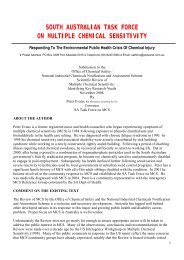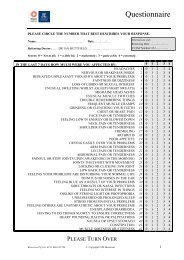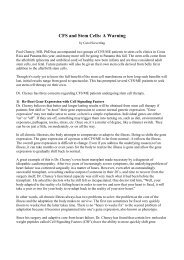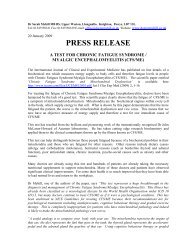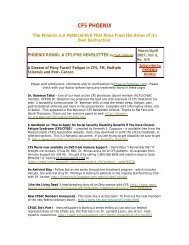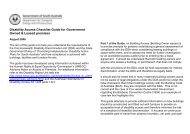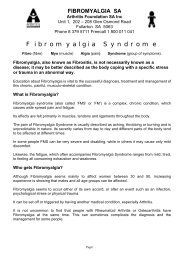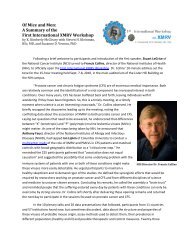1813 01 REUMA3 Editoriale - ME/CFS Australia
1813 01 REUMA3 Editoriale - ME/CFS Australia
1813 01 REUMA3 Editoriale - ME/CFS Australia
Create successful ePaper yourself
Turn your PDF publications into a flip-book with our unique Google optimized e-Paper software.
Etiopathogenetic mechanisms of Fibromyalgia Syndrome 29diating pain pathways; it was the first neuropeptideto be studied extensively in FMS and hypothesizedto be involved in abnormal pain processing (52,53). The co-morbidity of psychiatric conditions,such as depression, and the alterations of sleepwakecycles, mediated by 5-HT, seemed to support5-HT dysregulation (54).Levels of 5-HT, its precursor tryptophan, and itsmetabolites 5-HIAA and 5-HTP were measured inthe blood, in the cerebrospinal fluid (CSF), and inthe urine of FMS patients. The most consistent resultsof all attempts to confirm an abnormality in5-HT neurotransmission were derived from CSFsamples. The pioneering studies did not measure 5-HT directly but found decreased levels of 5-HIAAin FMS patients as compared to controls, includingboth pain-free and low back pain subjects (55-57). The results from studies measuring 5-HT levelsin the serum of patients with FMS were lessconsistent. One group documented higher 5-HTlevels in FMS patients versus controls (58), evenusing platelet-rich plasma for the assay, whereasanother group found lower serum 5-HT levels inFMS than in RA patients (54). The hypothesis wasthat increased platelet activation may lead to a releaseof 5-HT into the plasma fraction. FMS patientswith a high plasma-to-serum 5-HT ratio presentedwith a higher frequency of orofacial painand anxiety (59). Similarly in another study, thenumber of tender points and serum 5-HT levelssignificantly correlated inversely, comparing FMSpatients with both RA patients and healthy controls(52). Whether or not the inconsistency may beexplained by changes within the serotonin transporterhas been discussed. A polymorphism in the5-HT transporter gene regulatory region (S/S genotype)is associated with decreased 5-HT transportermessenger RNA transcription and decreased 5-HTuptake in vitro. As mentioned previously, this polymorphismhas been shown to have a significantlyhigher distribution in FMS cohort (29).To summarize, a dysregulation of 5-HT metabolismin FMS is likely but has not been proven to bethe sole cause of central sensitization of FMS.Substance P, an 11-amino-acid neuropeptide, actsas a neuromodulator via the NK1 receptor. It sensitizesthe neurons to the effects of other neuromodulators.Stimulating the release of 5-HT in thespinal cord decreases the release of substance P intothe spinal cord (60).Substance P levels in the CSF of FMS patients havebeen found to be reproducibly high in five differentstudies (61-64). A trend toward correlation ofCSF substance P levels and pain severity in FMSover time has been suggested (65). Other chronicpain states, such as low back pain and painful neuropathy,present with low levels of CSF substanceP (66-69). High CSF concentration of substance Prepresents the most prominent neurochemical abnormalityfound in FMS patients.There are significant negative correlations betweenlevels of substance P and 5-HT, its precursor tryptophan(TRP), and its primary metabolite 5-HIAAin the serum of patients with FMS. High serumconcentrations of 5-HIAA and TRP showed a significantrelation to low pain scores. Low levels of5-HIAA and high concentrations of substance Pwere both positively correlated with more severesleep disturbance (70). Nerve growth factor (NGF),which stimulates the production of substance P insmall, afferent, unmyelinated neurons, was foundto be elevated in the CSF of FMS patients with primaryFMS, but not in FMS with an associatedpainful inflammatory condition (secondary FMS)(71). This finding addresses the clinical finding ofsubgroups in FMS (72-74). Elevated CSF substanceP could be a common link between primaryand secondary FMS, but the groups differ withregard to the mechanism responsible for the elevatedsubstance P. In primary FMS, NGF seems toinduce the elevated CSF substance P from centralinterneurons. In secondary FMS, the peripheral inflammation,so characteristic of the underlyingrheumatic or infectious conditions, may be responsiblefor the elevated CSF substance P. Forthese reasons, NGF could be critical to the initiationor perpetuation of the painful symptoms ofprimary but not secondary FMS (71).Neuroendocrine abnormalitiesThe neuroendocrine system, together with the autonomicnervous system and immune system, playsa fundamental role in the maintenance of the homeostasisof the organism in a large variety of environmentalsituations, namely stressful events ofboth physical and psychological origin. FMS is frequentlyassociated with a rich history of stressful/traumaticevents (75) and is characterized by anumber of symptoms similar to those typical ofstress-related conditions, such as irritable bowelsyndrome or chronic fatigue syndrome.The hypothalamic-pituitary-adrenal axis(HPA-axis)FMS patients have been shown to present withHPA axis alterations (76-80). Compared to con-



